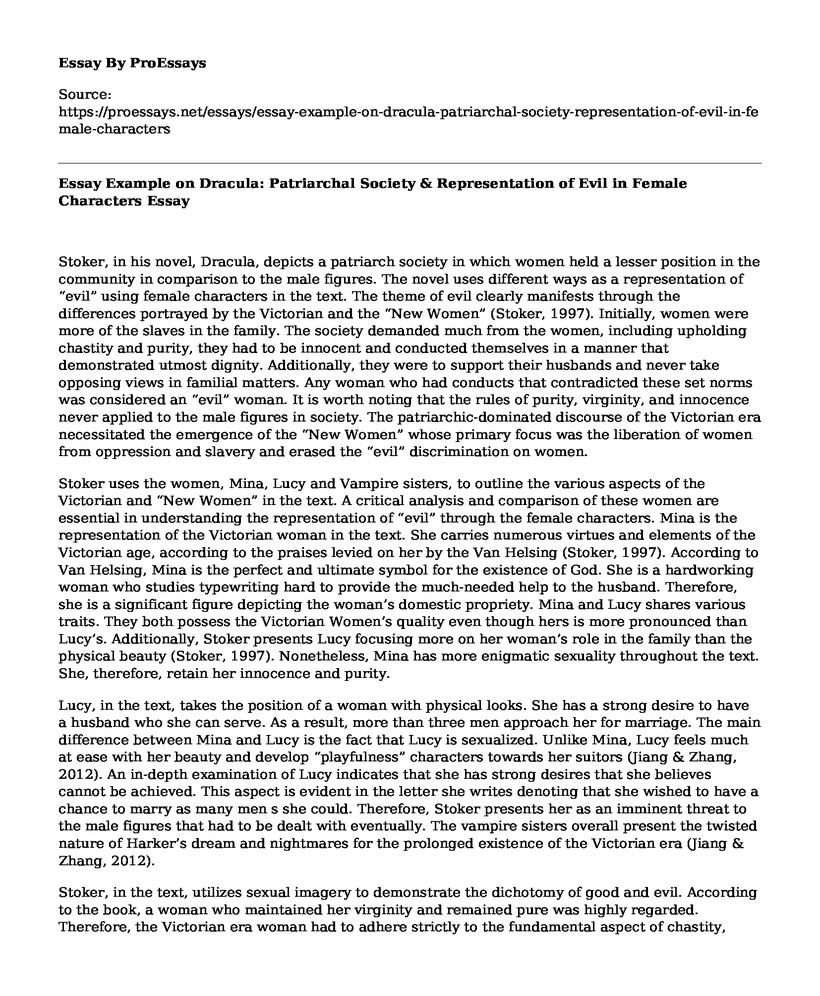Stoker, in his novel, Dracula, depicts a patriarch society in which women held a lesser position in the community in comparison to the male figures. The novel uses different ways as a representation of “evil” using female characters in the text. The theme of evil clearly manifests through the differences portrayed by the Victorian and the “New Women” (Stoker, 1997). Initially, women were more of the slaves in the family. The society demanded much from the women, including upholding chastity and purity, they had to be innocent and conducted themselves in a manner that demonstrated utmost dignity. Additionally, they were to support their husbands and never take opposing views in familial matters. Any woman who had conducts that contradicted these set norms was considered an “evil” woman. It is worth noting that the rules of purity, virginity, and innocence never applied to the male figures in society. The patriarchic-dominated discourse of the Victorian era necessitated the emergence of the “New Women” whose primary focus was the liberation of women from oppression and slavery and erased the “evil” discrimination on women.
Stoker uses the women, Mina, Lucy and Vampire sisters, to outline the various aspects of the Victorian and “New Women” in the text. A critical analysis and comparison of these women are essential in understanding the representation of “evil” through the female characters. Mina is the representation of the Victorian woman in the text. She carries numerous virtues and elements of the Victorian age, according to the praises levied on her by the Van Helsing (Stoker, 1997). According to Van Helsing, Mina is the perfect and ultimate symbol for the existence of God. She is a hardworking woman who studies typewriting hard to provide the much-needed help to the husband. Therefore, she is a significant figure depicting the woman’s domestic propriety. Mina and Lucy shares various traits. They both possess the Victorian Women’s quality even though hers is more pronounced than Lucy’s. Additionally, Stoker presents Lucy focusing more on her woman’s role in the family than the physical beauty (Stoker, 1997). Nonetheless, Mina has more enigmatic sexuality throughout the text. She, therefore, retain her innocence and purity.
Lucy, in the text, takes the position of a woman with physical looks. She has a strong desire to have a husband who she can serve. As a result, more than three men approach her for marriage. The main difference between Mina and Lucy is the fact that Lucy is sexualized. Unlike Mina, Lucy feels much at ease with her beauty and develop “playfulness” characters towards her suitors (Jiang & Zhang, 2012). An in-depth examination of Lucy indicates that she has strong desires that she believes cannot be achieved. This aspect is evident in the letter she writes denoting that she wished to have a chance to marry as many men s she could. Therefore, Stoker presents her as an imminent threat to the male figures that had to be dealt with eventually. The vampire sisters overall present the twisted nature of Harker’s dream and nightmares for the prolonged existence of the Victorian era (Jiang & Zhang, 2012).
Stoker, in the text, utilizes sexual imagery to demonstrate the dichotomy of good and evil. According to the book, a woman who maintained her virginity and remained pure was highly regarded. Therefore, the Victorian era woman had to adhere strictly to the fundamental aspect of chastity, purity and dignity. The sexual symbolization used by the author has a relationship with the Christianity views of purity. The early Christians and the biblical laws as applied in the Jewish cultures upheld virginity as one of the most significant and most cherished elements in a woman. However, the author’s view of the sexual image regarding the male figures and the prostitutes in the Victorian era slightly differs from that of Christianity.
References
Jiang, Y., & Zhang, X. H. (2012). An Analysis on Dracula from Cultural Perspective. English Language and Literature Studies, 2(4), 100-105.
Stoker, B. (1997). Dracula. Broadview Press.
Cite this page
Essay Example on Dracula: Patriarchal Society & Representation of Evil in Female Characters. (2023, Aug 31). Retrieved from https://proessays.net/essays/essay-example-on-dracula-patriarchal-society-representation-of-evil-in-female-characters
If you are the original author of this essay and no longer wish to have it published on the ProEssays website, please click below to request its removal:
- Domestic Violence: Annotated Bibliography
- Paper Example on Communication Models: Mythology Theory
- Gun Violence and Social Media Crisis Cases Paper Example
- Illicit Drug Use Should Be Illegal in the US - Essay Sample
- Essay Example on Everyday Use: Exploring Heritage & Values
- Essay on Full-Time Workers Struggle With Poverty: A Look Into Roger Weisberg's 'Waging a Living'
- Essay Example on Achilles: A Significant Contributor to World Literary History







